MIT is one of five academic research organizations selected to join the National Institute of Environmental Health Sciences (NIEHS) in a new consortium to study toxicological and environmental health problems.
The Toxicogenomics Research Consortium will use genomics to understand how disease occurs, identify potential environmental hazards, predict potential disease, identify susceptible or exposed individuals and prevent disease.
Each of the five organizations will receive more than $7 million over five years from NIEHS. At MIT, Professor Leona Samson of the Division of Bioengineering and Environmental Health (BEH) will lead studies in the use of gene expression profiling to explore environmental alkylating agents stresses on human health.
Other MIT faculty who will be involved in the consortium are Professor John Essigmann of BEH and chemistry, Associate Professor Linda Griffith of BEH and the chemical engineering, and Associate Professor Peter Sorger of BEH and biology.
Grants to the organizations were awarded on a competitive basis after the organizations responded to a request for applications issued by NIEHS. The consortium will coordinate efforts by NIEHS staff scientists at the headquarters facility in Research Triangle Park, N.C., with those of scientist grantees at the research organizations.
"We know we can stretch the research dollar by having scientists at NIEHS and grantees at universities work in concert," said NIEHS director Kenneth Olden. "But perhaps more important, we know that bringing ideas together in science increases the advances we achieve."
In addition to MIT and NIEHS, other members of the new consortium are the University of North Carolina at Chapel Hill, Oregon Health and Science University, the Fred Hutchinson Cancer Research Center at Seattle and Duke University.
A version of this article appeared in MIT Tech Talk on November 7, 2001.





